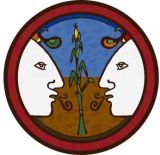¡Hola todos!
What a wild ride this first week with Pop Wuj has been. After spending the first couple days getting the lay of the land I was able to start working on the Safe Stove Project in full force. This started on Tuesday and Wednesday with half-day excursions to complete one stove and get started on another. After getting a taste on those days, I spent the weekend with a Guatemalan engineer and Spanish teacher named Mynor in another community learning how to build the stoves from start to finish. For those of you who may have never built a stove before, let me explain a little about what that looks like.
The first phase consists of laying a 90cmx125cm base of cinder blocks, held together by cement. The cement has to be mixed by hand with either a shovel or a spade. While the cement is being mixed two cinder blocks need to be cut in half, and then a third cut into quarters. When I told my dad this his response was "How do you cut the blocks? Do you have a masonry saw?", the short answer to this is no. In order to cut the cinder blocks they have to be chopped in half with one of our two machetes. Before beginning the Safe Stove Project I had never considered just how many uses there are for machetes, I have since learned they can be used for pretty much anything. Once the cement has been mixed and the cinder blocks have been cut we use small trowels to fill the gaps in the blocks and let it sit to dry. This is a very messy process if, like myself, you're not so handy with trowels or cement. There are three layers of cinder blocks in the first layer, and after each layer is completed the first stage of the stove is finished.
Once the first stage has dried overnight we are free to get started on the second stage. This stage is similar to the first and consists of placing three layers of brick atop the cinder blocks with both clay and cement. This stage is significantly more difficult than the first as both the clay and cement need to be mixed by hand which is a tough job when there's only two people, as was the case over the weekend. Once the clay and have cement have been mixed you can begin laying the bricks on top of the cinder blocks from the day before. When laying the bricks it is important to account for the door at the front and the chimney at the back, but other than that it's pretty straight forward. Upon reflection the hardest part of the work was mixing the clay and cement. It's hard to say how long it took to mix the two pastes because in my head it took 16 hours at least; realistically it probably took more like an hour. Michelle Obama arms here I come.
 |
| Mynor putting the final touches on the Safe Stove this weekend. |
Working with Mynor this weekend was challenging it was so cool to be invited into a space as intimate as someone's home. Everyday with Pop Wuj has proved to be an incredible learning experience so far and I'm so eager to see what the next few months have to offer.
